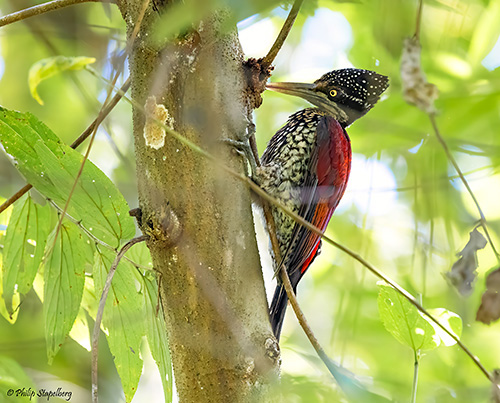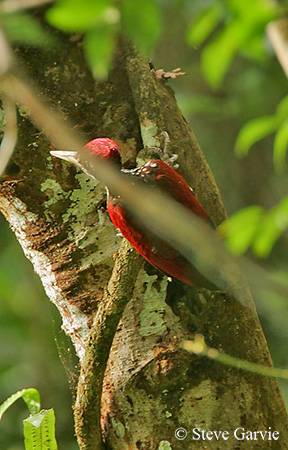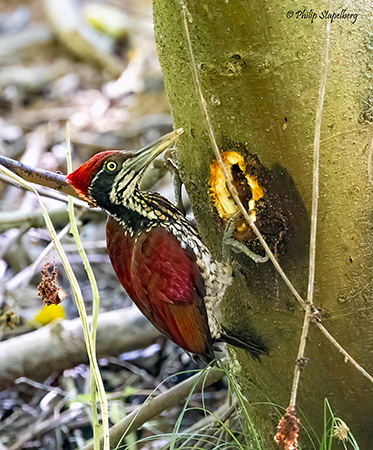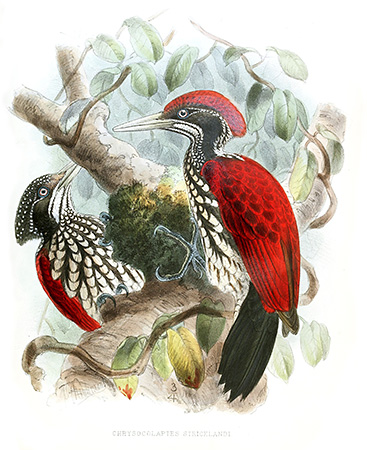Fr: Pic de Ceylan
Ang: Crimson-backed Flameback
All: Ceylonsultanspecht
Esp: Pito sultán de Ceilán
Nd: Ceylonese Goudrugspecht
Sd: rödryggig sultanspett
Photographers:
Steve Garvie
RAINBIRDER Photo galleries
Philip Stapelberg
GALLERY
Alan & Ann Tate
AA Bird Photography
Illustrator:
John Gerrard Keulemans (1842–1912)
Illustration’s Origin: A History of the Birds of Ceylon. Volume 1
Text by Nicole Bouglouan
Sources:
HANDBOOK OF THE BIRDS OF THE WORLD Vol. 7 by Josep del Hoyo-Andrew Elliott-Jordi Sargatal – Lynx Edicions – ISBN: 8487334377
WOODPECKERS, an identification guide of the woodpeckers of the world by Winkler Hans and Christie David – Helm – ISBN: 0395720435
Woodpeckers of the World: The Complete Guide by Gerard Gorman – Editeur: A&C Black, 2014 – Helm Photographic Guides - ISBN: 1408147173, 9781408147177
Fatbirder - The World’s Richest Information Resource about Birds for Birders
CREAGUS@Monterey Bay (Don Roberson)
Wikipedia, the free encyclopaedia
Crimson-backed Flameback
Chrysocolaptes strickland
Piciformes Order – Picidae Family
INTRODUCTION:
The Crimson-backed Flameback was formerly a subspecies of Chrysocolaptes lucidus, a large woodpecker found in the southern Philippines.
The Crimson-backed Flameback is now considered a full species. It is endemic to Sri Lanka where it frequents the forested parts of the wet zone and the mountains, up to 2,000 metres of elevation. It feeds on invertebrates on large trees and snags and sometimes on the ground.
This species typically nests in tree hole excavated by both mates. Two or three white eggs are laid and both adults share the nesting duties.
The Crimson-backed Flameback is described as common to locally common. It is affected by habitat loss but currently, the species is not globally threatened.
DESCRIPTION OF THE BIRD:
Biometrics:
Length: 29-30 cm
The Crimson-backed Flameback adult male has entirely dark red upperparts, often brightest on the rump. On the upperwing, the coverts are dark red too, but the flight-feathers are browner and the dark primaries are spotted white, a pattern well visible in flight. The tail is blackish, with stiff rectrices to support the bird when scaling on vertical surfaces such as tree trunks.
The underparts are whitish with conspicuous dark brown scaly pattern, becoming more buffy and less distinct on the belly.
The underwing is spotted black and white, forming parallels stripes on open wings.
On the head, crown and crest are deep red. The rest of the head is black, but we can see a narrow white supercilium formed by a line of small white spots. The nape is black with white spots. The throat is white with narrow, black central gular line. Both submoustachial and malar stripe are white, but a narrow, black submoustachial line is visible between them.
The straight, long, slightly chisel-tipped bill is pale yellowish-cream. It is broader across the nostrils. The long sticky tongue is about three times the length of the bill.
The eyes are pale yellow to whitish, surrounded by dark purplish eyering.
Legs and feet are grey. The zygodactyl feet have two toes forwards and two backwards, allowing the bird to cling to tree trunks.
The female resembles male, but she lacks the red crest. The head is black, except chin and throat. The black crest is spotted with white, like the postocular supercilium.
The juvenile has duller appearance overall. The crest is longer and shaggy.

RANGE:
The Crimson-backed Flameback is endemic to Sri Lanka where it occurs from the highest hills to the lowlands. It is absent in the extreme North of the island.
HABITAT:
The Crimson-backed Flameback is found in both lowland and hill forests, but mainly in the wet zone and the mountains where it may occur to high elevations, up to 2,000-2,100 metres. It is also observed in wooded areas such as plantations and coconut groves.
CALLS AND SONGS: SOUNDS BY XENO-CANTO
The presence of the Crimson-backed Flameback is signalled by its call, a distinct trill uttered in flight. It is described as a high-pitched, trilled “kiriririri” also given when the bird is perched.
We can also hear other sounds such as a whinnying call “tree tree tree” and occasionally a single, squeaky “keek”.
But this species produces another sound, the typical drumming made by both sexes by hammering the trees with their strong bills. Drumming is used by the male to advertise the territory, but also to attract a potential mate.
Each roll is very rapid (about 20 strikes/second) rising a little before fading out. It may last 2,5/4 seconds.
These birds have strong neck muscles and thick skull, allowing them to drum for long time without any problem.

BEHAVIOUR IN THE WILD:
The Crimson-backed Flameback usually forages on large trees and snags within the forest and occasionally on isolated trees in open areas. It may sometimes drop to the ground while searching for prey.
It feeds on various invertebrates such as beetles and ants, but spiders, larvae, arthropods and caterpillars are also probably part of the diet. Some plant material such as nuts and fruits are also consumed.
The Crimson-backed Flameback carves into the tree bark to reach insects with its long, sticky, barbed tongue, about three times the length of the bill. This long, particular tool allows the bird to find and catch insects and spiders hidden deep in bark crevices. Then, the tongue is retracted to the back of the skull.
This species is known for “cleaning” the forest while eating numerous tree-boring insects. In addition, it leaves old nest holes after the breeding period that will be used by other species.
The Crimson-backed Flameback male drums strongly to attract a female and to defend the territory. Following pair formation and copulation, both mates excavate the nesting cavity in tree trunk, up to 20 metres above the ground. Both adults share all the nesting duties.
The Crimson-backed Flameback is a sedentary, endemic breeder on the island.
It is a good flier, performing the typical undulating flight of most members of the family Picidae.
REPRODUCTION OF THIS SPECIES:
The breeding season takes place from October to March, with sometimes a second period in August-September.
The Crimson-backed Flameback nests in tree hole. The cavity is excavated by both adults, up to 20 metres above the ground. The hole itself is often pear-shaped, and we can see an oval vertical entrance. Inside, the nest-chamber is lined with some wood ships.
The female lays 2-3 white eggs and both parents incubate, the male mainly at night because during the day, it defends the nesting site and the territory. The chicks are fed by both parents.
No more information.

PROTECTION / THREATS / STATUS:
The Crimson-backed Flameback is described as common to locally common, and reasonably widespread throughout the range.
However, the species is affected by habitat loss caused by forest clearance involving degradation and fragmentation of the wooded areas. This problem is the main cause of the decline of the population.
The species is protected under the Fauna and Flora Protection Ordinance, and the population is not considered globally threatened at the moment.
The Crimson-backed Flameback is currently evaluated as Least Concern.

John Gerrard Keulemans
(1842–1912)